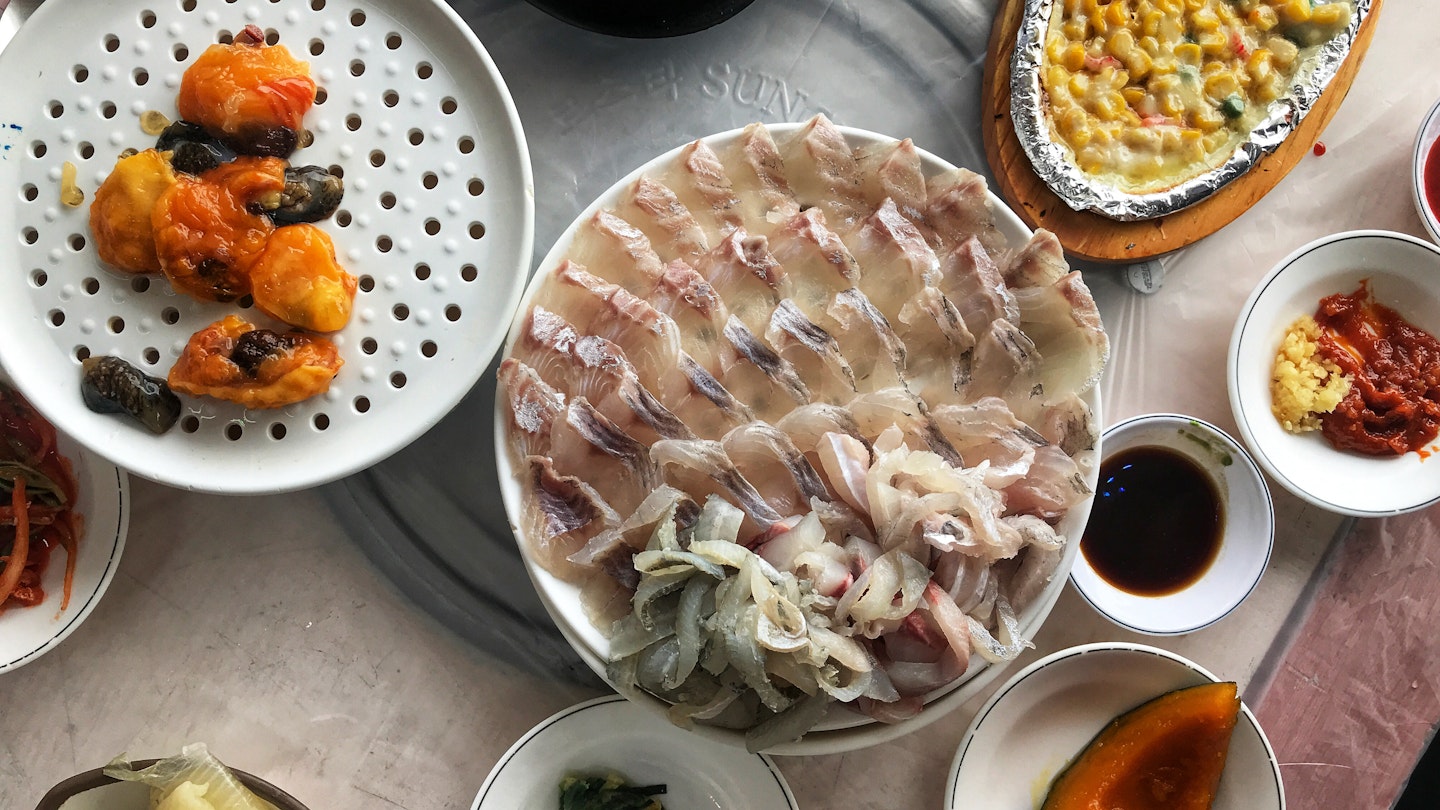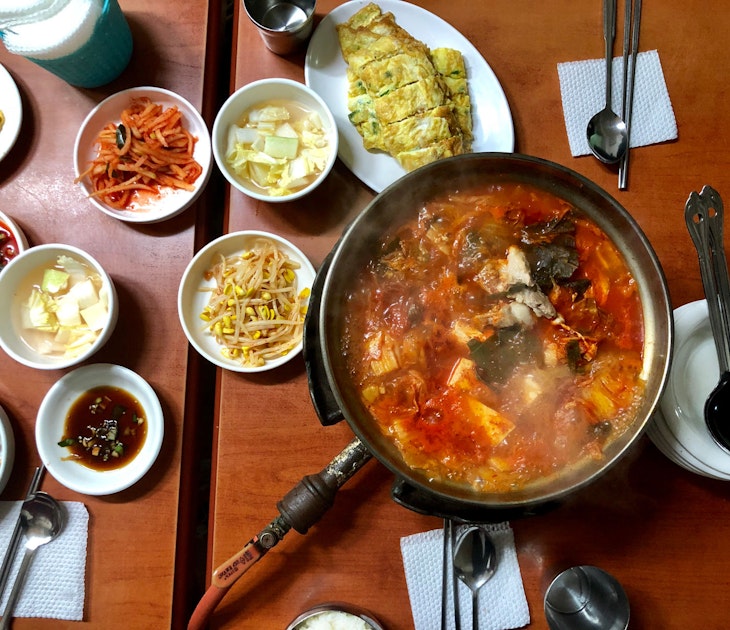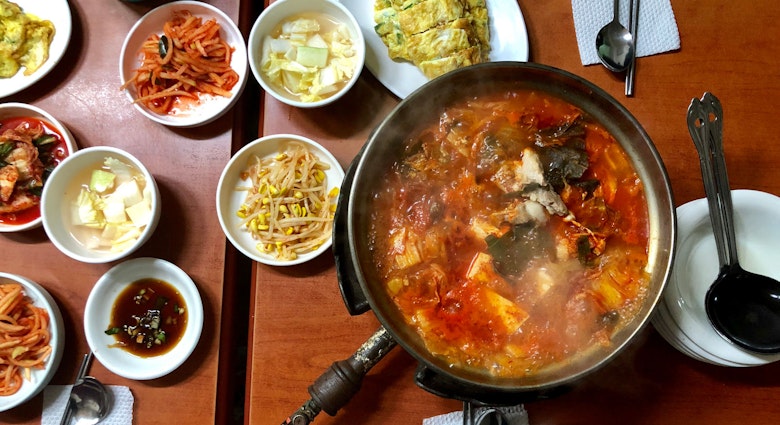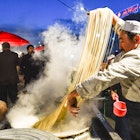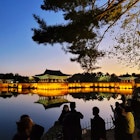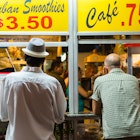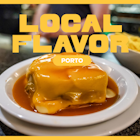The culinary landscape of Busan – South Korea's second city – is marked by lively markets, iconic street food and tasty, local variations of typical Korean fare – and thanks to its oceanside location, the seafood is second-to-none.
Add to that stellar coastline views, dynamic nightlife and sophisticated arts and cinema and you’ll see why Korea’s second-largest city is regarded by visitors as the country’s top holiday spot. Pack your looser-fitting clothes and get a taste of Busan with these one-of-a-kind dishes.

Dwaeji gukbap (돼지국밥)
With Busan often playing second fiddle to Seoul, perhaps it’s no wonder that the city’s most emblematic dish is a humble but hearty one. Dwaeji gukbap is a simple stew featuring heaps of thinly sliced pork, rice and spring onion in a thin, milky broth, but you can customise your perfect flavour profile by incorporating various bits of banchan (반찬, a panoply of side dishes commonly served with meals in Korea). Raw vegetables like onions, hot peppers, whole garlic cloves, chopped leeks and even kimchi dial the taste up, as do flavour-packed accompaniments like saeujeot (새우젓, tiny, brined shrimp); chogochujang (초고추장, a hot pepper paste with vinegar); and ssamjang (쌈장, a spicy soybean, sesame and red pepper paste).
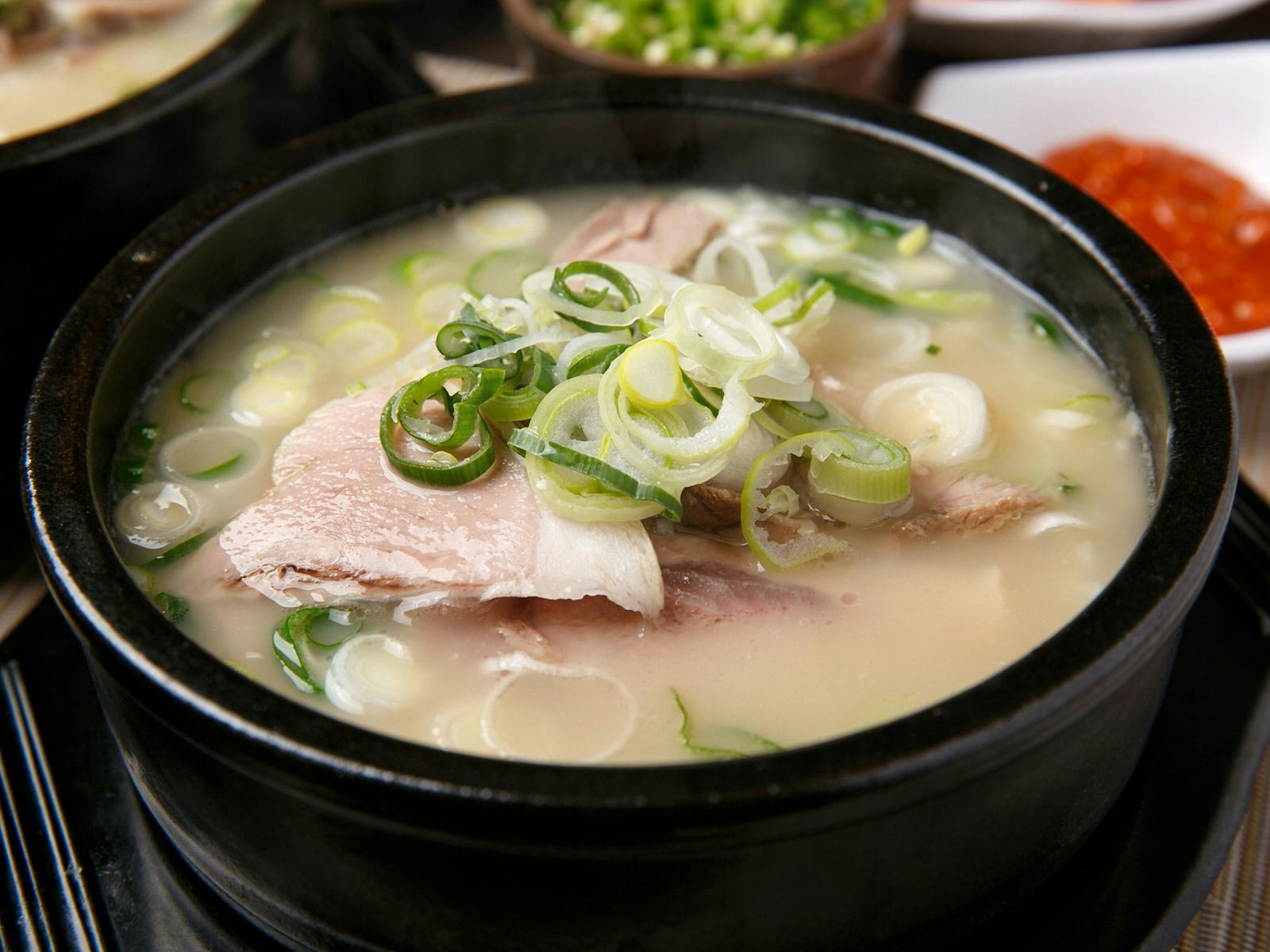
While it may appear pretty straightforward – served in a stone bowl – the broth’s preparation is labour intensive. In Jungang-daero, a corridor known as Dwaeji Gukbap Alley houses a row of restaurants specialising in the dish. It’s good for any meal, from a robust breakfast kickstarter to a post-party pick-me-up. The atmosphere is particularly great at Gyeongju Gukbap, where a serving runs around ₩7000.
Milmyeon (밀면)
With its stellar beaches, there’s no better place than Busan to build up a sweat while basking in the sun. Cool down and fuel up at once with milmyeon, a chilled noodle soup found only here. Similar to the typical Korean naengmyeon (냉면), it consists of a nest of twisted wheat noodles (naengmyeon are made from buckwheat or sweet potato flour) in an a icy, meat-based broth. And we literally mean icy – there are visible chips afloat when it arrives.
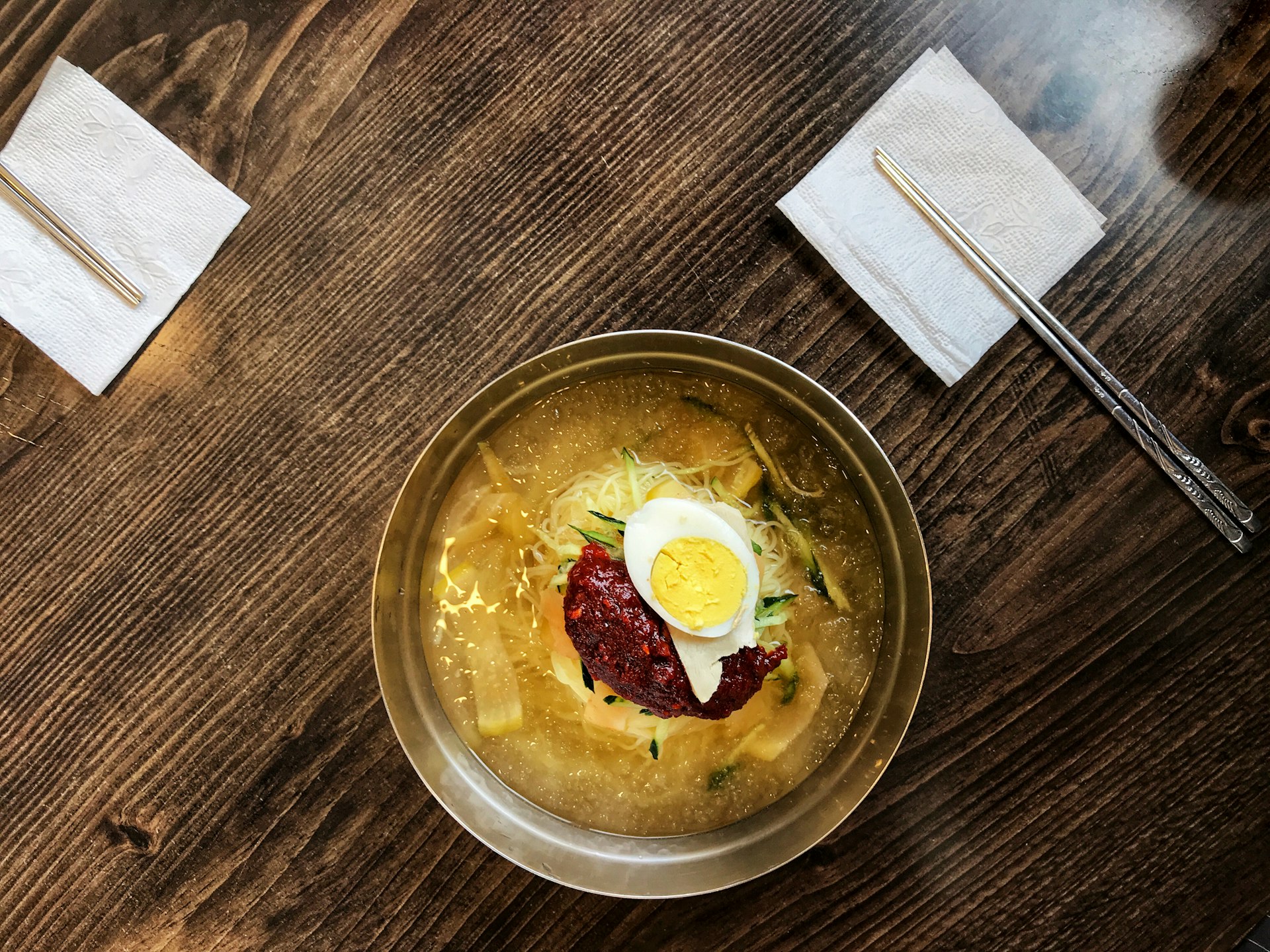
Served in a metal bowl to keep everything cool, the noodles are adorned with julienned vegetables like radish, cucumber and carrot, followed by a dollop of chogochujang (spice is another characteristic that differentiates milmyeon from the usual naengmyeon). It’s then topped with a fistful of thinly sliced pork and garnished with half a hard-boiled egg.
Deconstruct the artful presentation with the pair of scissors that come as a standard utensil (like with most noodle dishes in Korea) for a much more wieldy and tasty experience as the ice slowly melts and flavours meld. For a tangy kick, add a dash of mustard or vinegar. Milmyeon Jeonmunjeom, where you can enjoy a bowl for ₩6000, is just a ten-minute walk from Busan's crowning beach, Haeundae.
Hoe (회)
A hoe (pronounced like ‘when’ without the ‘n’) is a platter of thinly sliced, mild white fish, or saengseon hoe (생선 회), similar to Japanese sashimi and served with a variety of banchan. Dip in chogochujang, ssamjang or wasabi and soy sauce – or stack on top of lettuce or perilla leaf and adorn with sauce before wrapping it up like a tasty parcel and sending it down the hatch.
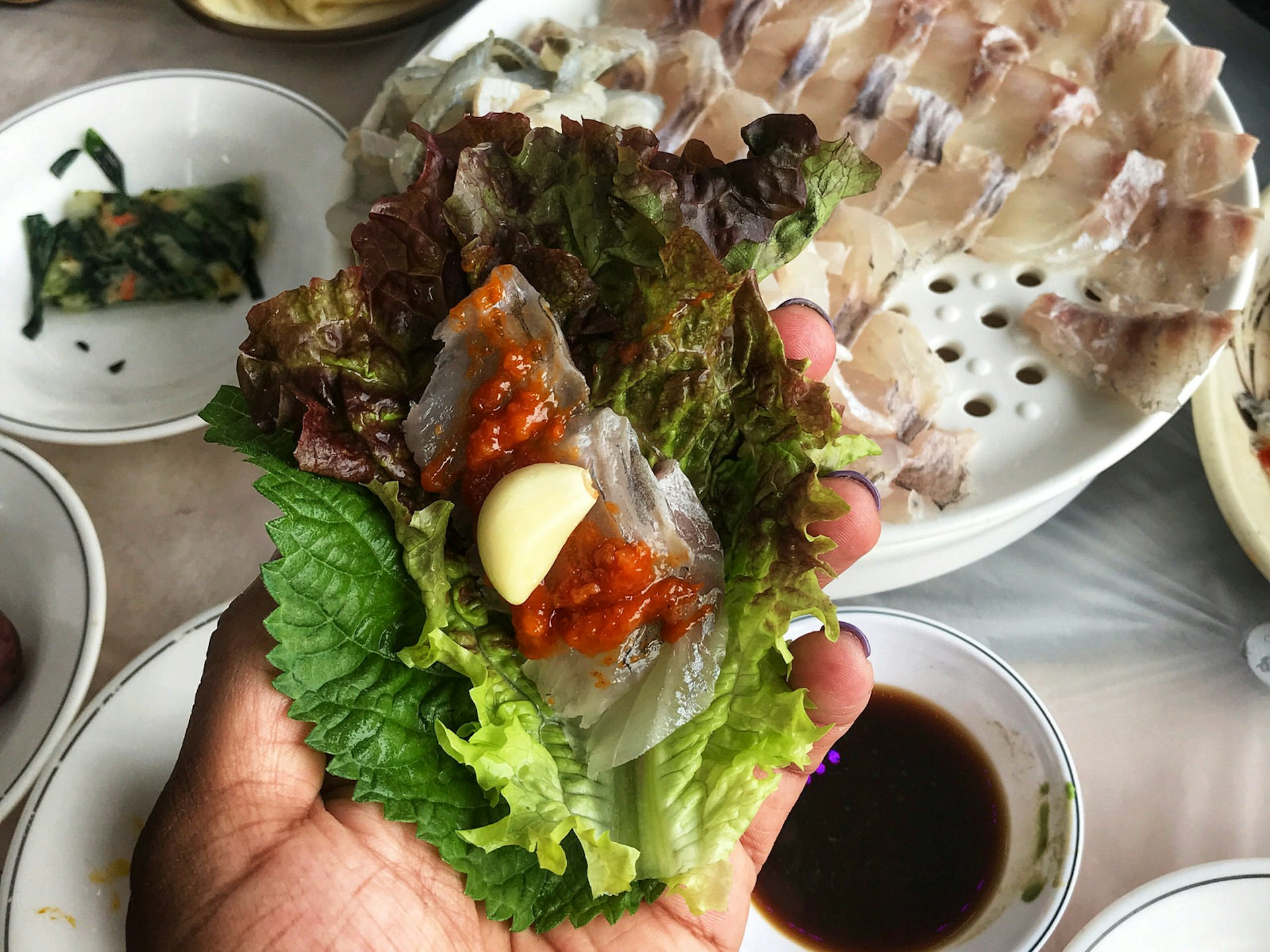
A saengseon hoe meal culminates with a side of rice and a bowl of spicy maeuntang stew(매운탕), made with the remaining fish heads and meat.
Technically, any kind of sea creature served raw is hoe. For something more adventurous, try sannakji (산낙지): longarm octopus. Though the octopuses are de-brained and chopped before being served, activity in the tentacles – where two-thirds of their neurons are located – cause posthumous wriggling. You can also eat the octopus whole; either way, chew with vigour, lest those suction cups refuse to release from your tongue without a fight. Gulp.
If a squirming cephalopod isn’t gripping enough to quell an appetite for the bizarre, give gaebul (개불) a go. Also known as a ‘penis fish’ – one glance at the creature’s rosy, phallic figure and the moniker is apparent – the gaebul isn’t actually a fish at all, but a girthy sea worm that’s found burrowed in the mudflats along South Korea’s southwest coast. Believed to be an aphrodisiac (of course), the taste is reminiscent of clam; and thanks to the worm’s water retention capacities, you may be met with surprising mouthful of salty spray while chewing it.

Get a hoe fix at Jackie’s Seafood in Jagalchi Fish Market – Jackie, the owner, won’t lead you astray with his recommendations (he’s also speaks English fluently). Meals start around ₩40,000
Naengchae jokbal (냉채 족발)
Food-themed streets are aplenty in Busan. Near BIFF Square, a locals' favourite is Bupyeong-dong’s Jokbal Golmok (부평동 족발 골목), or Pig Feet Alley, where a string of some 20 restaurants sling naengchae jokbal, a dish of chilled pig feet. The porky peds are steamed with soy sauce, ginger, garlic, scallions and a bit of sugar until tender, then de-boned and cut into thick slices. The Busan variety is served cold with jellyfish and crab meat, and garnished with vegetables like cucumber, carrot and onion – all awash in a mustardy sauce.
Despite the earthy origins of the porcine protein, partaking in a jokbal feast may be a boon for your health. Pork contains methionine, an amino acid that’s claimed to counter the unpleasant effects of alcohol and help nip hangovers in the bud. Packed with gelatin, jokbal boasts beauty-boosting properties and is said to promote smooth, wrinkle-free skin (buying into all those K-beauty trends just got a whole lot tastier). At any given jokbal joint, the dish runs about ₩30,000 and serves three to four people.
Eomuk (어묵)
Fishcake, known as eomuk or odeng (오뎅), is commonplace in Korea – and the country’s very best hails from Busan. The processed seafood staple is made from cuts of white fish that’s salted, pureed and steamed until fully cooked. It’s then sliced and diced into myriad shapes and sizes before assuming its place in dishes across the spectrum of Korean cuisine.

Across Busan, you’ll find the street food form of eomuk folded and skewered in pots of hot broth or chopped up with other ingredients in a bowl of soup known as eomuk guk. You can also get tasty and creative varieties that are enveloping some other form of protein (prawn, crab stick, sausage or a hunk of cheese) at Samjin Fish Cake (삼진 어묵), the leading purveyor in the country. There’s a flagship shop in Yeongdo, plus outlets in Busan Station, the Lotte Department Store in Seomyeon and the Shinsegae Department Store in Centum City. Eomuk prices start at ₩500 for a street cart skewer to upwards of ₩5000 for an elaborate creation at a Samjin shop.
Ssiat hotteok (씨앗 호떡)
Last but by no means least is ssiat hotteok, a dessert pancake and darling of the Busan street food scene. While hotteok (the dough of which is typically made from sweet rice flour for a delightfully chewy texture) can be sampled all over Korea, what sets the ssiat (seed) variety apart is a blend of sunflower and pumpkin seeds and pine nuts that are stuffed into a cinnamon and brown sugar filling when the pancake comes off the street cart griddle, crisp and piping hot.
While it’s believed that the seeds add a healthy element to these aromatic treats, they are anything but: the sinfully syrupy delights are like the love child of a cinnamon roll and a doughnut, served up fresh and gooey in a paper cup. They’re easiest to come by at carts in BIFF Square, Gukje Market and around Seomyeon – and at ₩1000 a pop, you may just develop a habit of picking one up at every turn.
